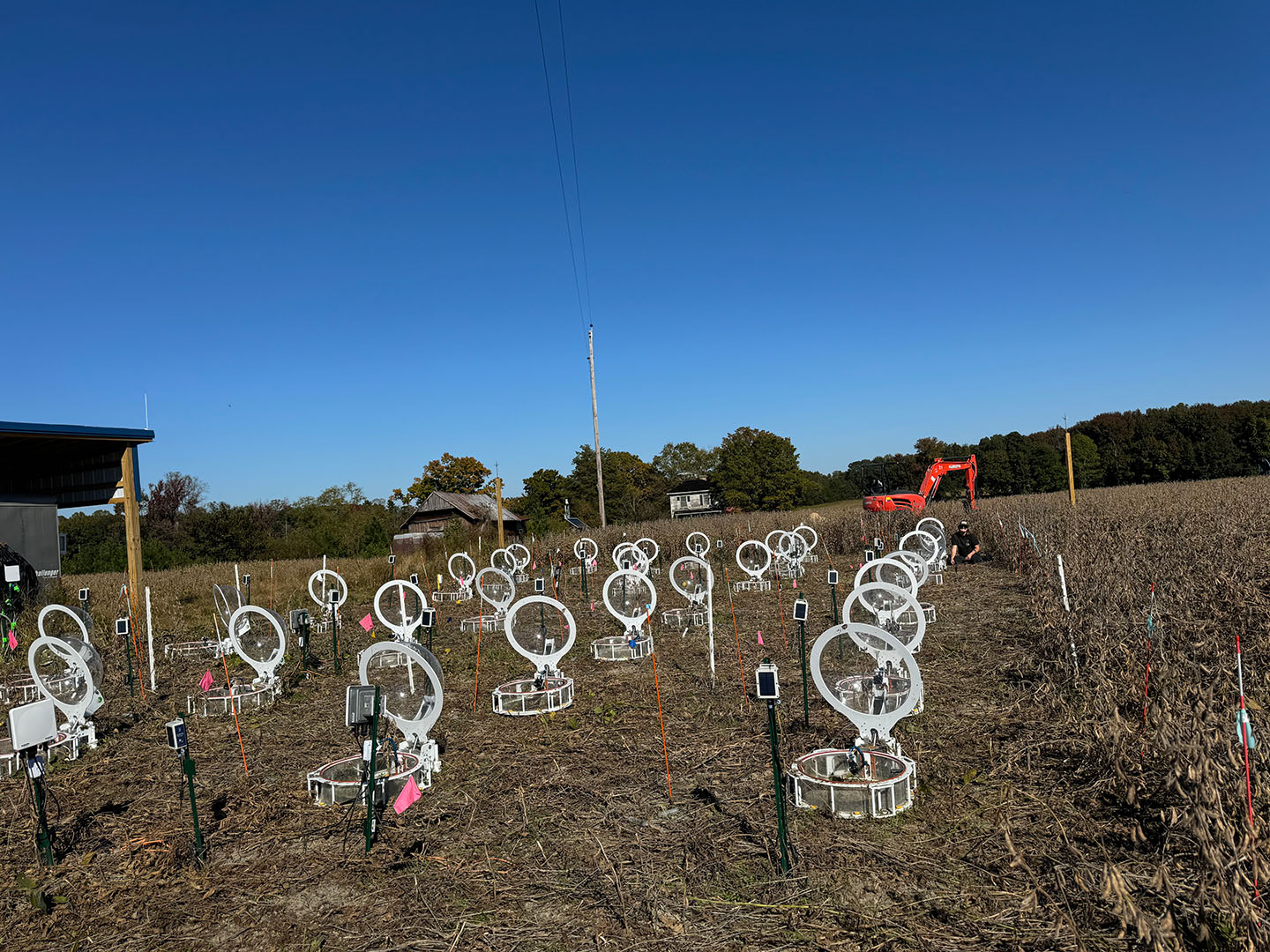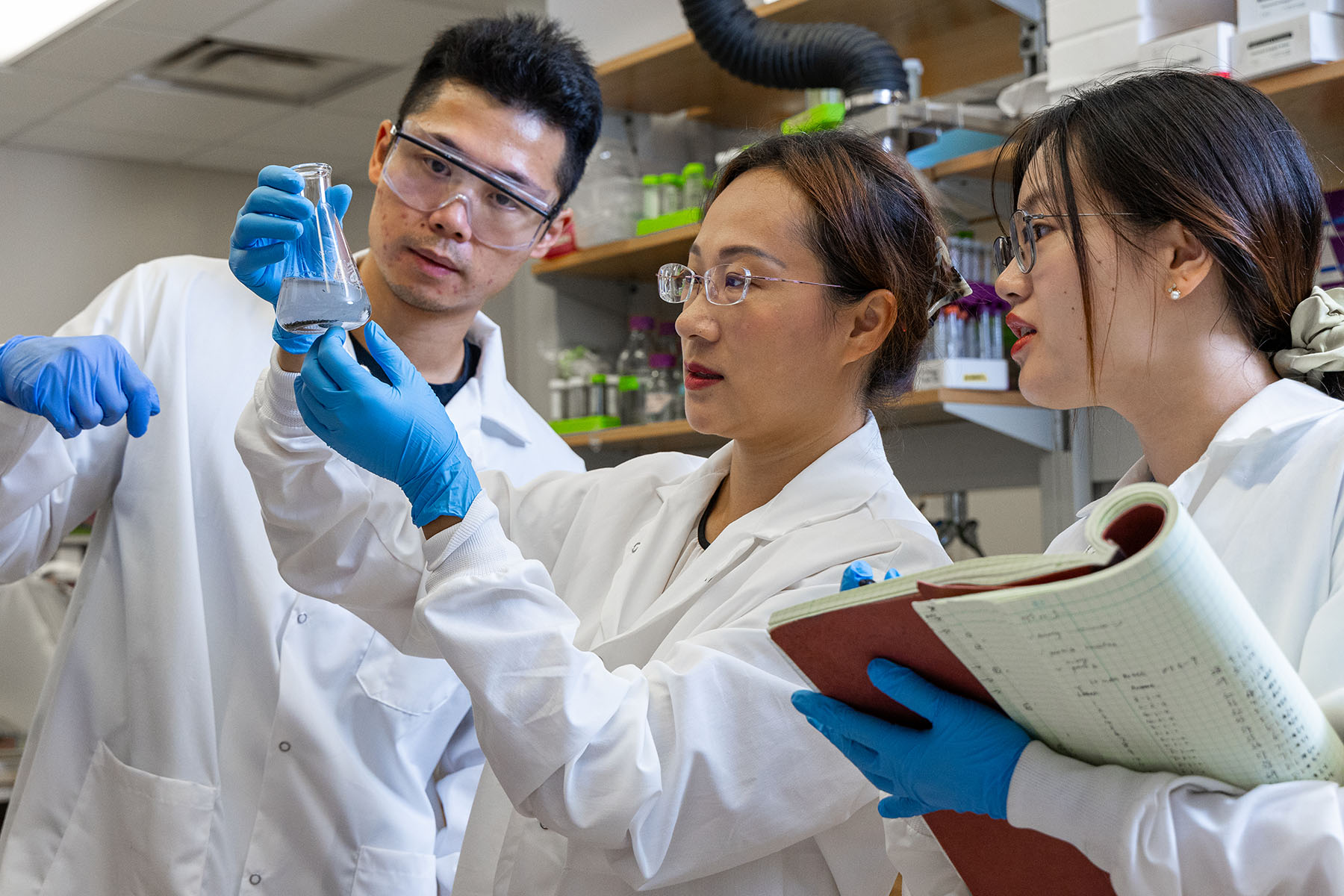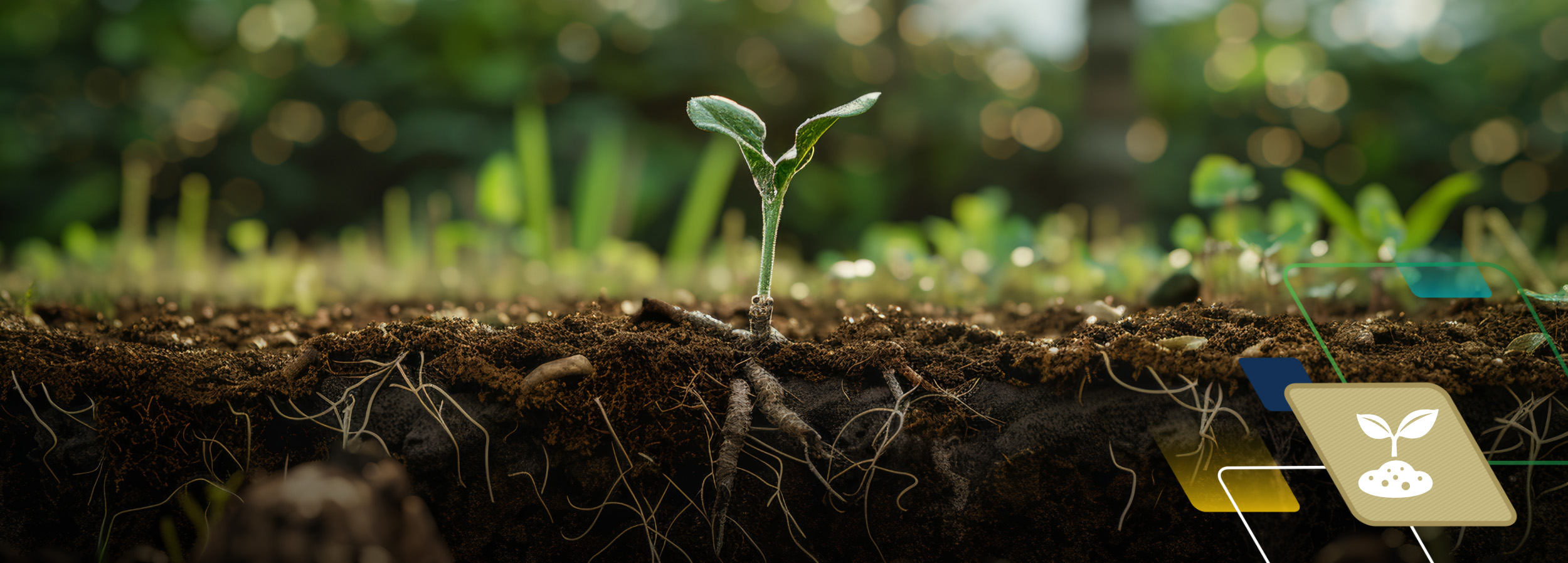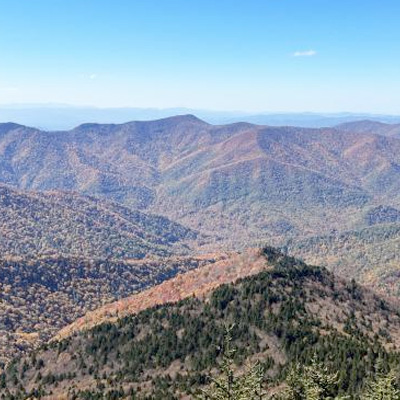Unearthing Climate Solutions
Georgia Tech researchers explore how to improve the planet, one rock at a time.
Clearing Carbon: Enhanced Weathering Removes Carbon and Improves Farming
Decreasing carbon dioxide in the air can start with dirt on the ground. School of Earth and Atmospheric Sciences Associate Professor Chris Reinhard has been working in farm fields worldwide to jumpstart a vital part of the natural carbon cycle.
Reinhard's specialty is how to keep planets habitable and how the carbon cycle influences this. “As a researcher, I’ve been thinking for a long time about carbon removal in natural systems, and building models to represent it and track how quickly carbon cycles through,” he said.

For the trial, researchers spread fine-grained basalt and till it into the soil, then measure how the greenhouse gas fluxes change. In addition to the carbon removal, they also looking for a drop in nitrous oxide (N2O) fluxes from the soil.
He decided to use these same tools to remove carbon from the atmosphere instead of just monitoring it.
Reinhard’s work is focused in part on a technique called “enhanced weathering,” a carbon dioxide removal approach that involves spreading rock dust over the land surface. These rocks can speed up a natural carbon removal process when they break down with water, forming soluble ions and consuming atmospheric CO2. While this process already happens naturally, intentionally using fine-grained rocks and targeting agricultural soils can expedite the process.
From the Upper Midwest’s Corn Belt to Georgia peanut farms and all the way to rice paddies in India, Reinhard is helping to test this theory across the planet. His team uses basalt, a volcanic rock, in most of their trials, but they are also trying to better understand how using limestone — a conventional agricultural practice known as “liming” — might also help reduce the climate impacts of agriculture.
However, not all farms are the same. “Crops have different needs in terms of soil pH and texture, so we need to monitor how different crops and soil types respond,” Reinhard said. Increases in crop yield along with carbon removal might help make the practice economically beneficial for farmers to participate.
“Farmers are interested,” he added. “Just the idea that they might be able to use a simple practice that allows them to grow even more peanuts and engage with carbon markets is enough to get us in the door in places like Georgia.”
Reinhard’s next step is evaluating more cost-effective techniques for tracking carbon removal while developing models that can reliably predict carbon removal rates.
“We’re excited about this process, but it is very important to us that it be brought to scale responsibly,” he said. “So we also spend a lot of time working with nonprofits and policy experts to try and make sure this can be a sustainable practice over time, and that it ultimately benefits folks on the ground.”
“We’re excited about this process, but it is very important to us that it be brought to scale responsibly. So we also spend a lot of time working with nonprofits and policy experts to try and make sure this can be a sustainable practice over time, and that it ultimately benefits folks on the ground” — Chris Reinhard
Predictive Paleontology: Studying Past Species Helps Us Preserve the Future
Fossils can tell us who thrived or barely survived in the prehistoric past, and in effect which creatures can adapt for the future. School of Biological Sciences Associate Professor Jenny McGuire studies conservation paleontology, a field that uses paleontological data to better allocate conservation efforts.
“I am interested in how anthropogenic landscapes and changing climates affect how and where plants and animals live in the past, in the present, and going into the future,” she said.
As the Earth’s climate shifts, organisms are more likely to migrate away from their home range to track the climates where they are best suited, a concept known as climate fidelity. “Plants and the animals will redistribute themselves across the landscape to continue living in comparable environments,” McGuire noted.

A student separates small bones and teeth from rocks. The activity shows the diversity of life that lived at Wyoming's Natural Trap Cave 20,000 years ago. (Photo by Allison Carter)
From her research, McGuire has noticed an interesting trend. While plants do maintain climate fidelity, animals are more likely to shift climates, especially as humans start encroaching on their environment. This suggests conservation efforts must prioritize species that rely on climate fidelity to survive.
McGuire analyzes pollen collected from all over North America to better understand climate fidelity. These pollen cores are made of sediment samples that determine the abundance of pollen in an area sometimes thousands of years in the past. McGuire combines this pollen database with paleo-climate data models using global circulation patterns that track past climate elements like temperature and precipitation. Her lab can also apply a similar process for mammal fossils to determine their climate niche. They combine the mammal data with publicly available topographic maps to ascertain how the environment has shifted over time.
“We’ve been using climate fidelity as a way to prioritize different taxa [groupings of biological organisms based on their shared characteristics],” McGuire said. “This can help us determine which of these taxa need help tracking climate going forward.”
From Coal to Concrete: Coming Up With New Uses for Old Waste
When coal burns, more than just CO2 is released into the atmosphere. The ash left over from the coal and its detritus need to go somewhere. Some can be used to create concrete and other infrastructure. The rest has been considered waste. For decades, North America has been littered with ponds full of coal ash that take up land, occasionally causing environmental catastrophes like contaminated drinking water.
“The advantage is that major coal ash pond failures have motivated increased control, and that's why we're doing a more engineering-driven job of disposing of or repurposing these materials,” said Susan Burns, professor in the School of Civil and Environmental Engineering (CEE).
As the U.S. moves toward using more natural gas for electricity, less ash is produced. But this ash is still needed for concrete. Burns works to repurpose the coal ash in these ponds, enabling them to be used for concrete and clearing the land at the same time. Coal ash is just one of the byproduct-use projects Burns studies. Her lab also researches how to use sediment dredged from the Savannah Harbor to make bricks. She regularly collaborates with fellow CEE Professor Kimberly Kurtis.
These reuse applications must have benefits beyond environmental ones. “We need to balance the engineering properties with the economic opportunities,” Burns said.
With this in mind, her lab analyzes the best place to store this repurposed waste so it’s close to sites that could use the building materials. Creating a commercially viable product motivates the energy industry to invest in these processes and keeps Burns pursuing this research.
Trash to Treasure: Finding Rare Earth Minerals in Waste

Tang, post-doctoral researcher Yinghao Wen, and Ph.D. student Hang Xu check out the reaction for recovering rare earth elements from combustion residue. (Photo by Chris McKenney)
From cerium in catalytic converters to the erbium found in fiber-optic cables, rare earth elements make society run. But most are mined and processed outside the U.S., and finding new domestic resources and establishing a supply chain are critical to keeping America competitive in the clean energy transition.
School of Earth and Atmospheric Sciences and School of Civil and Environmental Engineering Professor Yuanzhi Tang studies the recovery of critical minerals such as rare earth elements from existing waste sources like coal ash, waste-to-energy residue, scrap magnets, and mine tailings. Tang, who has a background in geochemistry, works with industry partners to collect samples and characterize the chemical forms of these critical minerals. From there, her team can determine the content of critical minerals in the waste stream and design targeted methods to extract these valuable resources.
“When we started this work seven or eight years ago, there wasn’t much talk about critical mineral recovery,” said Tang, who is also director of the Center for Critical Mineral Solutions and a campus initiative lead of sustainability resources for the Strategic Energy Institute and the Brook Byers Institute for Sustainable Systems. “We saw the opportunity, given the important roles these materials play in modern society and the rich chemistry behind their behavior in natural systems.”
Just as important as finding these critical mineral resources is ensuring the extraction process doesn’t cause more environmental harm. Tang's group uses environmentally friendly reaction conditions and biodegradable reagents to extract these critical minerals from wastes. They also work to make the process energy efficient while eliminating the secondary waste production.
“You don't want to take away a waste stream only to create another waste stream,” she said. Next up is scaling this research from a beaker in a lab to a full reactor, so commercialization for the American supply chain can begin.
“When we started this work seven or eight years ago, there wasn’t much talk about critical mineral recovery. We saw the opportunity, given the important roles these materials play in modern society and the rich chemistry behind their behavior in natural systems.” — Yuanzhi Tang

Writer/Media Contact: Tess Malone | tess.malone@gatech.edu
Photography: Chris McKenney & Allison Carter
Copy Editor: Stacy Braukman
Design: Tony Wilson
Climate Series
The climate is changing — and so is the way we respond. Georgia Tech researchers from across disciplines are teaming up to tackle the challenges of a warming world. From tracking air quality in urban environments to studying ancient fossils for clues about Earth’s past, these experts are driving innovations in climate resilience and mitigation.
Follow our new series to explore how Georgia Tech is helping shape a more sustainable future.


 Turning the Tide on Climate Change
Turning the Tide on Climate Change The Plants Seeking Refuge Across Our Dynamically Changing Planet
The Plants Seeking Refuge Across Our Dynamically Changing Planet Community Spotlight - Yuanzhi Tang
Community Spotlight - Yuanzhi Tang



